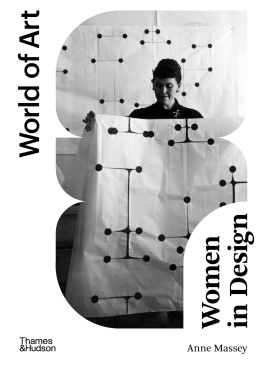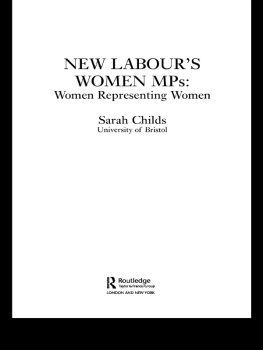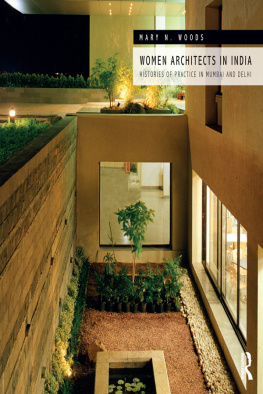
Where Are the Women Architects?
Where Are the Women Architects?
Despina Stratigakos
Published by Princeton University Press
Princeton and Oxford
in association with Places Journal
Copyright 2016 by Princeton University Press
Published by Princeton University Press, Princeton and Oxford in association with Places Journal
Princeton University Press, 41 William Street, Princeton, New Jersey 08540
In the United Kingdom: Princeton University Press, 6 Oxford Street,
Woodstock, Oxfordshire OX20 1TW
press.princeton.edu
All Rights Reserved
Cover illustration: Denise Scott Brown, photograph by Robert Venturi.
Courtesy of Venturi, Scott Brown and Associates, Inc.
Library of Congress Cataloging-in-Publication Data
Stratigakos, Despina, author.
Where are the women architects? / Despina Stratigakos.
pages cm
Includes bibliographical references and index.
ISBN 978-0-691-17013-8 (pbk. : alk. paper) 1. Women architects. I. Title.
NA1997.S77 2016
720.82dc23
2015027345
British Library Cataloging-in-Publication Data is available
Designed and composed by Yve Ludwig in Akkurat and Mercury
Printed on acid-free paper
Printed in China
10 9 8 7 6 5 4 3 2 1
To my grandmothers
One sold her dowry to study and become a teacher; the other, forbidden any education as a girl, sat on the school steps and wept
Introduction
Where Are the Women Architects? 1
Conclusion
Looking Back, Moving Forward 77
Acknowledgments
This book has been inspired by conversations and collaborations over the years with women who believed that architecture must change and decided to do something about it. The late Milka Bliznakov, who founded the International Archive of Women in Architecture at Virginia Tech, and on whose advisory committee I once served, demonstrated the passion and care involved in preserving the historical record. Beverly Willis, founder of the Beverly Willis Architecture Foundation (BWAF) in New York City, has been a model for bringing a broad variety of people to the table through participatory public education and synergistic partnerships with academia and industry; I am honored to serve on the BWAF board of trustees. At the Royal Institute of Technology in Stockholm, Meike Schalk and Katja Grillner, co-founders of the feminist architecture and research collective FATALE, have included me in their conversations about pedagogy and social outreach, providing insights from an international perspective. I have also benefited from the generosity of researchers in other countries who have undertaken major studies of gender equity in architecture and shared their experiences with me, including Annmarie Adams at McGill University and Karen Burns and Justine Clark at the University of Melbourne. Closer to home, I have talked shop and strategized with Lori Brown of Syracuse University, who co-founded ArchiteXX to create mentoring networks and programs to help young women stay in architectural practice. At the University at Buffalo, Kelly Hayes McAlonie, my collaborator on Architect Barbie, spurs us both on in the search for novel ways to raise women architects visibility. These women, and many others not mentioned here, have been my village in the shared goal of reforming architecture, and I thank them all for their ideas, energy, and good company.
Equally important to shaping this book have been my many conversations about architecture and publishing with Nancy Levinson, editor and executive director of Places Journal. She encouraged me to explore the possibilities of online publishing, and two of the chapters included here, on Architect Barbie and on Wikipedia, began as Places articles. I am deeply grateful for her thoughtful engagement with my work and to Josh Wallaert, senior editor, for his contributions. At Princeton University Press, I offer special thanks to my editor, Michelle Komie, for her vision and support. This is the second book on which we have collaborated, and I know we are not done yet. My thanks also go to Marilyn Martin, an exceptional copyeditor.
Two anonymous readers commented on the manuscript, and I am grateful for their valuable suggestions. The chapter on Architect Barbie owes a particular debt to the architecture faculty and students at the University of Michigan, who, years before she became a real toy, gamely agreed to try their hand at designing prototypes. Their dolls continue to be a source of provocation and amusement. I had the good fortune to write this book while teaching a graduate seminar on gender and architecture at the University at Buffalo School of Architecture and Planning. Over the semester, the participants, an incredible group of young women, nourished and challenged my writing with their observations and questions. I thank them for reminding me what this is all about.
Where Are the Women Architects?
Introduction
Where Are the Women Architects?
Walking into a lecture hall, attending a convention, sitting in a boardroom, participating on a jury, or strolling through an exhibitionthese are just some of the times that I have wondered, Where are the women architects? And I am not alone in asking this question. In the past few years, a chorus of voices has begun to ask why women, who first began studying architecture 140 years ago, continue to struggle to gain a foothold in the profession. Despite womens increasing enrollments in architecture schools since the 1980s, their numbers in practice have flatlined, and the higher one moves up the career ladder, the further they decline. At the top, measured by the professions highest awards and honors, they drop to nearly zero. This attrition of women in architecture and the career hurdles they face readily evoke building metaphors, such as a leaky pipeline and the glass ceiling. When one considers, however, the generations of dreams and work and ambitions that have been lost to us, it seems that the more appropriate term for this phenomenon is tragedy.
In this book I set out to explore a question that has long troubled the profession, diminishes its luster, and shows no sign of fading away. I begin in with a history of the question and its contexts, stretching from the 1870s to the 1970s. Since the nineteenth century, women as well as men have posed the question of womens absence in architecture, some arguing for change and others for the status quo. My aim here is less to chronicle womens entry into the profession, which other authors and books have done, than to track an unfinished dialogue that has haunted architecturein a cycle of acknowledging and then abandoning its gender issuesfor a very long time.
brings the picture up to date, looking at the current status of women in architecture, from their first experiences as students to their climb up the professional ladder. The view that emerges makes clear why the question of womens slow progress has reemerged in recent years, and more urgently than ever: it is hard to look at the statistics and not feel alarmed. Female architecture graduates continue to struggle to enter and stay in practice, large salary gaps persist, sexism on the job seems to be getting worse, and women remain vastly underrepresented in the professions leadership roles. Indeed, this perspective suggests less the question of why women leave architecture than of why they would pursue it at all.
But if we look at the status of the question itselfhow it is being pushed in unprecedented ways and by a new range of voices into the forefront of public and professional discussions about gender equitythe sense of a hopeless and grim continuity begins to dissolve. Indeed, this book has been timed to help identify and strengthen a rising third wave of feminism in architecture, which follows on the first wave that emerged at the end of the nineteenth century and the second wave that began in the early 1970s and continued into the 1990s. The current movement is not entirely distinct from the second one; many of the participants are the same, and their voices did not, in any case, disappear in the interim. What marks it, however, as a new and exciting development are the many young women (and men) who are joining in the call for change, as well as the international reach of their interventions. This new generation of advocates harness todays conditions and possibilities, including global marketing and new forms of technology and communication.
Next page








